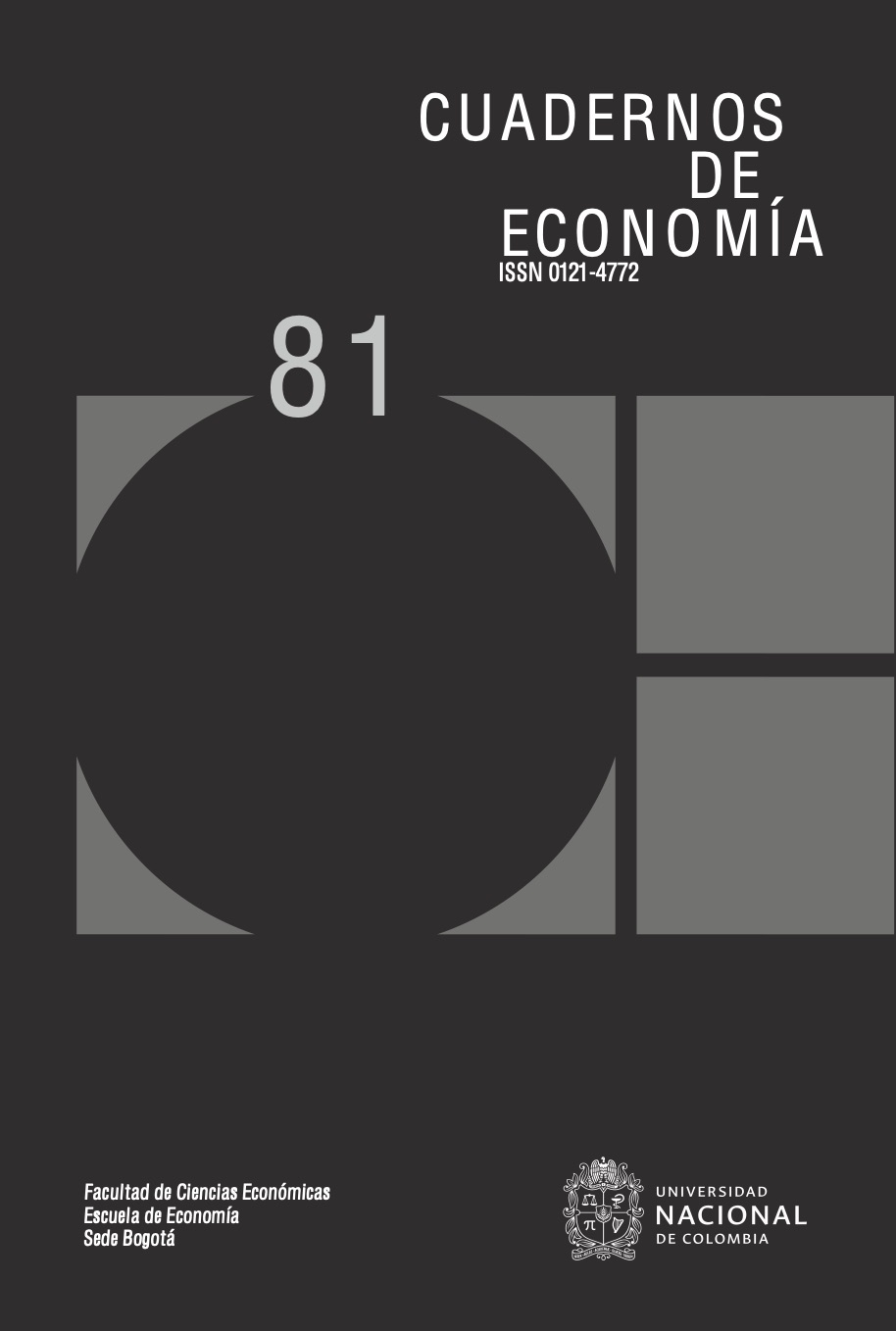Liquidity preference in a world of endogenous money: A short-note.
Preferencia por liquidez en un mundo de dinero endógeno: una nota corta.
Preferência de liquidez em um mundo de dinheiro endógeno: uma nota curta.
DOI:
https://doi.org/10.15446/cuad.econ.v39n81.78536Keywords:
Liquidity preference, endogenous money, Keynesian macroeconomics, financial markets (en)preferencia por la liquidez, dinero endógeno, macroeconomía keynesiana, mercados financieros (es)
preferência pela liquidez, dinheiro endógeno, macroeconomia keynesiana, mercados financeiros (pt)
Downloads
We argue that even in the case that banks are able to maintain the interest rate at a level that they want (the most “radical” version of the theory of endogenous money), liquidity preference continues to constitute a key element when determining the real equilibrium of the economy. In a framework of endogenous money, the Keynesian theory of liquidity preference still constitutes a theory that determines level of income. Financial markets matter, and the Kaldorian idea that liquidity preference “ceases to be of any importance” can only be defended under a set of very restrictive assumptions.
En este artículo argumentamos que incluso en el caso de que los bancos puedan mantener la tasa de interés al nivel que deseen (la versión más “radical” de la teoría de dinero endógeno), la preferencia por liquidez sigue constituyendo un elemento clave en la determinación del equilibrio real de la economía. En un marco de dinero endógeno, la teoría keynesiana de preferencia por la liquidez es aún una teoría para la determinación del nivel de ingreso. Los mercados financieros importan, y la idea kaldoriana sobre la relevancia de la preferencia por la liquidez solo puede defenderse con un conjunto de supuestos muy restrictivos.
Neste artigo argumentamos que inclusive em caso de que os bancos possam manter a taxa de juros ao nível esperado (a versão mais “radical” da teoria de dinheiro endógeno), a preferência por liquidez continua constituindo um elemento chave na determinação do equilíbrio real da economia. Em um marco de dinheiro endógeno, a teoria keynesiana de preferência pela liquidez é ainda uma teoria para a determinação do nível de ingresso. Os mercados financeiros importam, a ideia kaldoriana sobre a relevância da preferência pela liquidez só pode defender-se com um conjunto de supostos muito restritivos.
References
Asensio, A. (2017). Insights on endogenous money and the liquidity preference theory of interest. Journal of Post Keynesian Economics, 40(3), 327-348.
Bertocco, G. (2018). The Zero Lower bound and the asymmetric efficacy of monetary policy: a view from the history of economic ideas. Italian Economic Journal: A Continuation of Italian Economist Magazine and Journal of Economists, Springer, Italian Society of Economists, 4(3), 549-566.
Bertocco, G., & Kalajzic, A. (2014). The liquidity preference theory: A critical analysis, economics and quantitative methods. Department of Economics, University of Insubria.
Carlin, W., & Soskice, D. (2015). Macroeconomics: Institutions, instability, and the financial system. Oxford: Oxford University Press.
Dafermos, Y. (2012). Liquidity preference, uncertainty, and recessions in a stock-flow consistent model. Journal of Post Keynesian Economics, 34(4), 749-776.
Dow, S. (1997). Endogenous Money. In G. C. Harcourt, & P. A. Riach (Eds.), A “second edition” of the general theory, (pp. 61-78). London: Routledge.
Fontana, G., & Setterfield, M. (2009). Macroeconomic theory and macroeconomic pedagogy. New York: Palgrave MacMillan.
Godley, W., & M. Lavoie (2007). Monetary economics. An integrated approach to credit, money, income, production and wealth. New York: Palgrave MacMillan.
Kaldor, N. (1985). Economics without equilibrium. Cardiff: University College Cardiff Press.
Lavoie, M. (2009). Taming the new consensus: Hysteresis and some other post keynesian amendments. In G. Fontana & M. Setterfiel, Macroeconomic theory and macroeconomic pedagogy (pp. 191-213). New York: Palgrave MacMillan.
Lavoie, M., & Reissl, S. (2018). Further insights on endogenous money and the liquidity preference theory of interest (Working Paper Series). ExSIDE, 1-33.
Pasinetti, L. (1981). Structural change and economic growth: A theoretical essay on the dynamics of the wealth of nations. Cambridge: Cambridge University Press.
Moore, B. (1988). Horizontalists and Verticalists. The macroeconomics of the credit money. Cambridge: Cambridge University Press.
Palley, T. (1994). Debt, aggregate demand, and the business cycle: An analysis in the spirit of Kaldor and Minsky. Journal of Post Keynesian Economics, 16(3), 371-390.
Palley, T. (2013). Horizontalists, verticalists, and structuralists: The theory of endogenous money reassessed. Review of Keynesian Economics, 1(4), 406-424.
Palley, T. (2017). The theory of endogenous money and the LM schedule: Prelude to a reconstruction of ISLM. Brazilian Journal of Political Economy, 37(1), 3-22.
How to Cite
APA
ACM
ACS
ABNT
Chicago
Harvard
IEEE
MLA
Turabian
Vancouver
Download Citation
CrossRef Cited-by
1. Andrea Borsato. (2022). An agent-based model for Secular Stagnation in the USA: theory and empirical evidence. Journal of Evolutionary Economics, 32(4), p.1345. https://doi.org/10.1007/s00191-022-00772-9.
Dimensions
PlumX
Article abstract page views
Downloads
License
Copyright (c) 2020 Cuadernos de EconomíaCuadernos de Economía through the Libraries Division of the Universidad Nacional de Colombia promotes and guarantees open access to all its contents. The articles published by the journal are available globally with open access and licensed under the terms of Creative Commons Attribution-NonCommercial-No_Derivatives 4.0 International (CC BY-NC-ND 4.0), which implies the following:




















